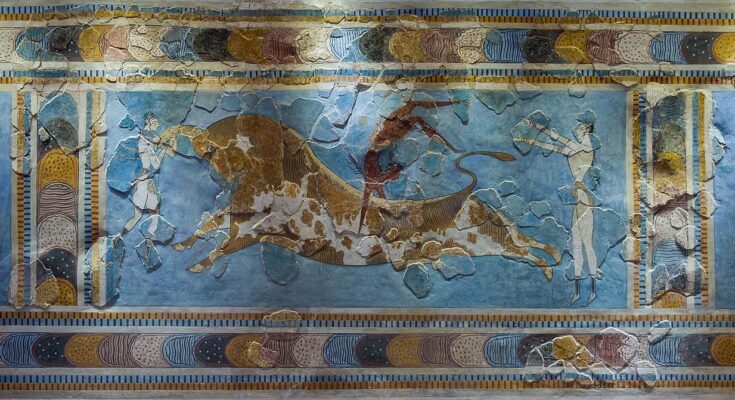In Plato’s famous account of Atlantis, he describes various aspects of the island’s culture. One notable aspect was that the people of Atlantis engaged in bull fighting.
Since many scholars believe Plato’s account was inspired by one or more actual civilizations, is there any historical basis for this particular aspect of the culture? Let’s examine how the Minoans explained the bull fighting of Atlantis.
The bull fighting of Atlantis
To begin with, let us consider what Plato actually wrote about bull fighting on Atlantis. The following passage comes from Critias, a dialogue by Plato, written around 360 BC:
“There were bulls who had the range of the temple of Poseidon; and the ten kings, being left alone in the temple, after they had offered prayers to the god that they might capture the victim which was acceptable to him, hunted the bulls, without weapons, but with staves and nooses; and the bull which they caught they led up to the pillar and cut its throat over the top of it so that the blood fell upon the sacred inscription.”
According to this passage, bulls were let loose in the Temple of Poseidon. The rulers of Atlantis would hunt the bulls with “staves and nooses” rather than weapons. That is, they would use sticks and ropes to capture them.
Once captured, they would lead the bulls to a sacred pillar on which there was a sacred inscription. This pillar was located within the Temple of Poseidon. There, the animals would be sacrificed.
The Minoan connection to Atlantis
It is worth asking why we might expect this description of Atlantis to even have a historical origin. After all, did Plato not just make up the story as an allegory? While this is the conclusion of many scholars, there is general recognition that Plato may have been inspired by genuine stories.
For example, the Encyclopedia Britannica notes the following:
“The legend of Atlantis may reflect ancient Egyptian records of a volcanic eruption on the island of Thera about 1500 BCE.”
In other words, the legend of Atlantis may well be connected to ancient records of the Minoan civilization. This civilization inhabited Thera at the time of that volcanic eruption.
Some scholars even go so far as to say that Plato was not trying to write an allegory at all but was simply recording a bona fide legend on the Minoans. In any case, it is very likely that the origin of Atlantis can be attributed at least in large part to the Minoans.
How the Minoans explain the bull fighting of Atlantis
With this likely origin in mind, did the Minoans engage in a practice of bull fighting similar to that described by Plato in his account of Atlantis? This was indeed the case.
Firstly, consider the fact that the practice supposedly took place within the Temple of Poseidon. This was an enormous temple dedicated to Poseidon and his lover in the middle of the island.
This would appear to match the Palace of Knossos near the middle of Minoan Crete. This large palace complex served temple functions. Furthermore, it was dedicated to Poteidan, the Minoan precursor to Poseidon, along with a goddess.
In the middle of the palace complex was a large Central Court. There is strong evidence that the Minoans performed a type of bull fighting in this court. Off to the sides of this Central Court were sacred crypts. Within each crypt was a sacred pillar with a sacred inscription on it. Evidence of bull sacrifices have been found there.
Clearly, the similarities between historical Minoan practices and Plato’s legendary description are striking. But what about the actual bull fighting itself?
Bull fighting or bull leaping?

One of the most common objections to the idea that the bull fighting of Atlantis came from the Minoans is the fact that the Minoans engaged in bull leaping. That is, an athlete would leap over the charging bull.
Some researchers take this to mean that they did not actually fight the bull. This would not align with Plato’s writing. However, is this really the case?
First of all, Plato never actually described the Atlanteans as “fighting” the bulls. Rather, he said they captured them with staves and nooses. This emphasizes the absence of violence against the bulls rather than the presence of it.
Perhaps most importantly, there are Minoan artifacts which demonstrate that the Minoans engaged in the capture of these bulls. One artifact in the British Museum, for example, is a seal which depicts a man having captured a bull with a rope.
A similar example is a different seal which appears to show the actual capturing of a bull, using what looks like some kind of forked staff aimed towards its neck. On the same seal, a second bull tramples a man.
The evidence from these seals shows that the Minoans did engage in the capture of bulls. They did not just leap over them. Rather, they engaged in this type of bull fighting and glorified it, depicting it on their seals. They used sticks and ropes to do so, just like Plato described.
Therefore, there is good evidence that Plato’s description of the bull fighting on Atlantis does come from the Minoans.



